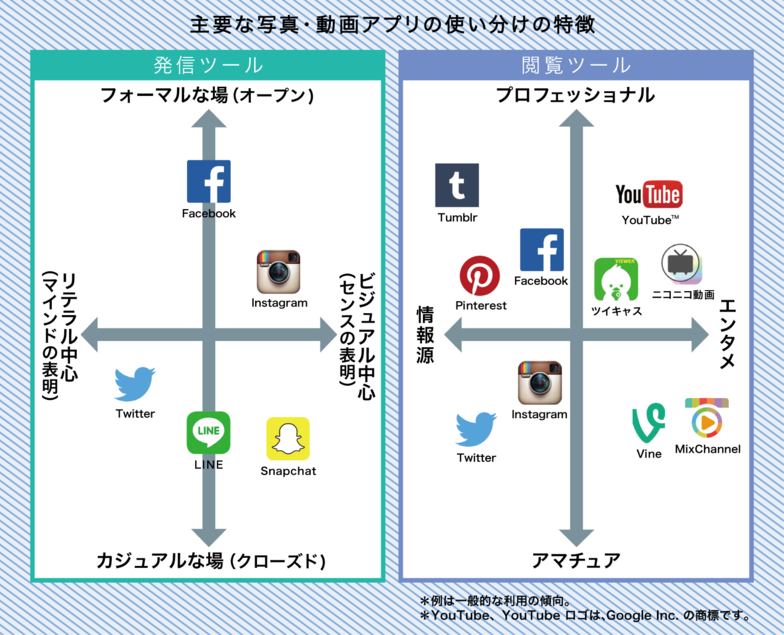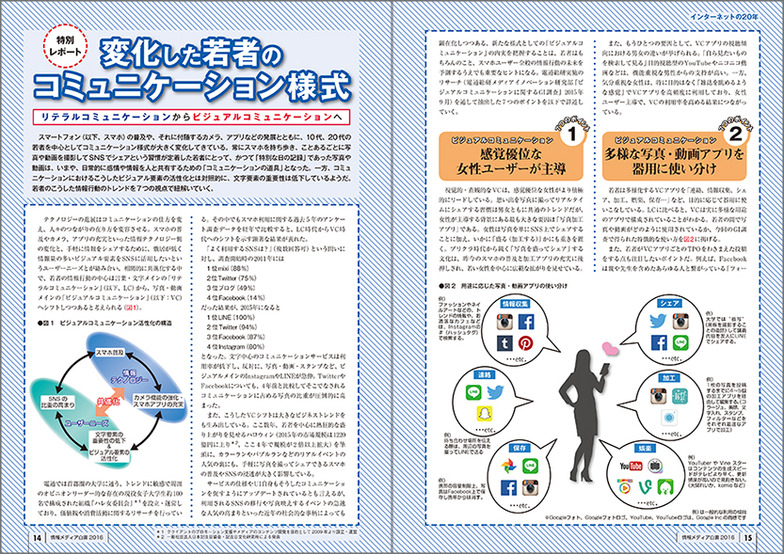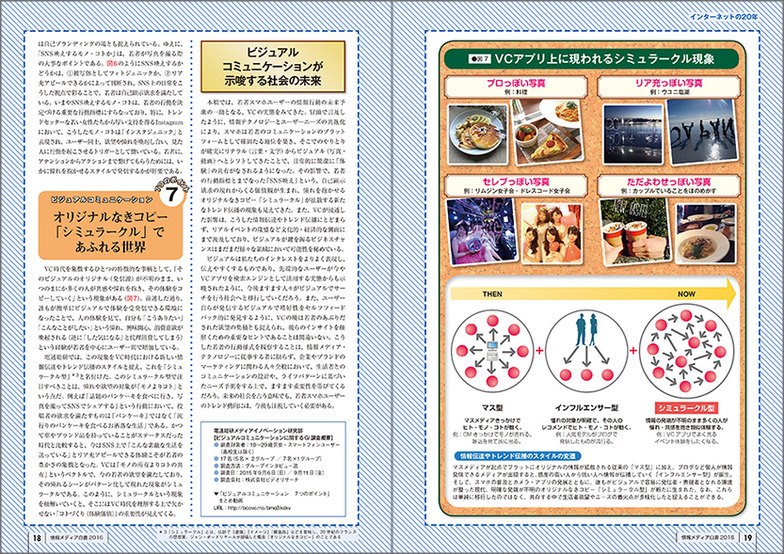Note: This website was automatically translated, so some terms or nuances may not be completely accurate.
20 Years of the Internet: Youth Communication Shifts from Text to Visuals
The Information Media White Paper 2016 was published on February 18. This series presents a digest version of the book's opening feature, "Twenty Years of the Internet."
The spread of the Internet has significantly changed how audiences access information. What happened in the 20 years since 1995, often called the dawn of the Internet in Japan? This series compiles research and analysis from the Media Innovation Research Department at DENTSU SOKEN INC., based on their unique perspective.
Part 1 explains the trends in information behavior among young smartphone users, shifting from text to visuals, through seven key points.

For young people who constantly carry smartphones, habitually take photos and videos at every opportunity, and share them on SNS, photos and videos—once reserved for "recording special days"—have now become everyday "tools for communication" to share emotions and information with others. In contrast to this surge in visual communication, the importance of text-based communication (literal communication) appears to be declining.
Understanding the substance of this 'visual communication' provides crucial insights not only for young people but also for predicting the future information behaviors of all smartphone users. Seven key points were extracted from research conducted by DENTSU SOKEN INC. (DENTSU SOKEN Media Innovation Research Department 'GI Survey on Visual Communication,' September 2015).

Visual and intuitive visual communication is more actively led by women, who tend to be more sensory-oriented. While the habit of taking photos of memories and sharing them in real time is a common trend among both genders, the biggest factor driving women's leadership is "photo editing apps."
Women place significant emphasis not only on sharing photos on SNS but also on how to "enhance" (edit) them. This culture, continuing from the purikura era, has seen widespread adoption, particularly among young women, driven by the recent proliferation of smartphones and the abundance of editing apps.
Another factor is the difference in viewing tendencies between men and women regarding visual communication apps. Purpose-driven viewing platforms like YouTube and Niconico Video, where users search for and watch what they want to see, are highly favored by function-focused men.
In contrast, mood-driven women tend to use visual communication apps frequently, often without a specific purpose, in a manner akin to "browsing a magazine."

Young people skillfully utilize the diversifying visual communication apps according to purpose—for "contact, information gathering, sharing, editing, entertainment, saving..." It's also noteworthy that young users post with an awareness of the appropriate time, place, and occasion (TPO) for each app.
For example, Facebook is perceived as a "formal space" connecting users with everyone, including parents and teachers, making it feel more formal. Consequently, users primarily post "reports" about significant life events like birthdays or graduation ceremonies.
Instagram is a "high-end space" where stylish people gather. Users present a more elevated version of themselves through stylishly edited photos, while carefully curating what they post to stay within its rules.
Twitter is a "casual space" where diverse races and cultures mix. Consequently, there's no need to put on a facade. Furthermore, they use multiple accounts simultaneously, employing different "characters" within each community to express themselves.
The diagram maps how survey participants differentiate their visual communication app usage by "posting perspective" and "viewing perspective."


Visuals that encourage intuitive information processing are ideal tools for satisfying information needs based on sensibility, such as fashion, beauty, cooking, and trendy spots. Consequently, searching for information on these themes using Instagram's "#" (hashtags, search keywords added by users to their photos) has become commonplace among young people.
Instagram's appeal also lies in its closed communication environment, connecting only a limited circle of friends or users with shared tastes. This allows users to access trustworthy information free from vested interests and efficiently obtain content that perfectly matches their interests and preferences. It's no exaggeration to call it a search window for trends connected by interest.
To become a source of information for young people, the key lies not in lengthy explanations but in delivering even a single photo that makes them want to go.

Whereas just a few years ago, blog-style posts—diary entries explicitly describing emotions through words—were mainstream, the trend has now shifted toward album-style posts: visually indexing and recording facts concisely.
Today's youth, raised in an era where SNS inherently risks information being exposed and instantly shared, coupled with the "Yutori education" that emphasized harmony over competition and the expectation to "read the air," are characterized by extreme awareness of others' gazes and a tendency not to express true feelings.
The literal communication era was essentially a one-way, "thought-up" style of communication where the poster unilaterally shared their thoughts. In contrast, the visual communication era can be reinterpreted as a two-way, "memory-sharing" style of communication based on empathy.
Another characteristic of visual communication is that as life logs accumulate in "album-like" formats, users' unconscious interests surface through photos, enabling them to discover their own preferences through self-feedback.
While e-commerce sites commonly offer recommendations based on purchase history, deciphering the needs revealed through this visual communication provides crucial insights into young consumers' mindsets and is an indispensable clue for guiding their purchasing behavior.

Visual communication has lowered the barriers to sending and receiving information, establishing the habit of casually capturing and sharing everyday moments through photos.
As a result, information that people wouldn't normally bother to mention is now shared. This allows us to see unfamiliar sides of everyone from acquaintances and friends to celebrities, creating opportunities for connection and familiarity.
Furthermore, sharing through photos and videos allows companies and brands to convey their worldview more effectively than words alone and deepen interest and understanding of products. It has also made sharing information worldwide, even across language barriers, much easier.
Visual communication facilitates flat engagement between users, allowing young people to connect with diverse worlds and broaden their interests.

To capture young people's attention amidst a sea of visuals, a distinctive "style" is essential. This style must spark interest in the split second they intuitively process information—through photo angles, editing, and a unified aesthetic.
It's also worth noting the insights hidden behind the photos young people share in visual communication. For them, it's also seen as a platform for self-branding.
Therefore, whether something is "Instagrammable" – factors like "Is the subject photogenic?" or "Can it showcase a fulfilling life?" – are crucial points for young people when taking photos. By coloring their daily lives on SNS through this lens, young people satisfy their desire for self-expression.
Now, things and experiences that look good on SNS have even become key behavioral indicators determining young people's actions. Particularly on Instagram, which enjoys strong support from trend-setting young women, such things and experiences are termed "Instagrammable." They function as triggers, evoking desire and aspiration among users and prompting viewers to take action.
To connect young people's attention to action, the key lies in how to communicate in a style that inspires aspiration.

A phenomenon symbolizing the visual communication era is when "the original source of a visual remains unknown, yet many people unknowingly develop empathy or admiration for it and begin copying the experience."
With the environment now allowing anyone to easily send and receive experiences visually, young users are increasingly experiencing a sense of longing, interest, and desire to consume when they see other people's experiences, thinking, "I want to be like that" or "I want to do that" (or conversely, they feel like they have done it and consume vicariously).
DENTSU SOKEN INC. views this phenomenon as a new style of information transmission and trend propagation in the age of visual communication, and has named it "simulacrum type"*.
What is noteworthy about this simulacrum type is that the object of admiration and desire is "experiences rather than things." For example, in the behavior of "going to eat the much-talked-about pancakes, taking pictures, and sharing them on social media," what satisfies the poster's desire is not the "pancakes" themselves, but the "trendy lifestyle of eating the popular pancakes."
Compared to the era when owning a car or brand-name goods was a status symbol, today it is experiences that allow young people to show off their fulfilling lives on social media that have become the symbol of affluence.
Visual communication satisfies the desires of today's youth through "sharing experiences rather than owning things," and the phenomenon that emerges when the scenes they long for become patterned is called simulacrum. This reveals the importance of "experience creation" (experiential value), which is essential for understanding the era of visual communication.
* "Simulacrum" is a French word meaning "false image," "image," or "imitation," and refers to the concept of "copies without originals" proposed by the 20th-century French philosopher Jean Baudrillard.
For details, see the book " Information Media White Paper 2016 ".


Was this article helpful?
Newsletter registration is here
We select and publish important news every day
For inquiries about this article
Author

Mariko Shitara
Dentsu Inc.
Solution Development Center
Forecast Research Department, Principal Researcher
As a communication planner, engaged in corporate and media brand strategy and event planning. Since 2015, served as a researcher at Dentsu Inc. Media Innovation Lab, studying information behavior and consumption insights among youth and women. Assumed current position in 2019. Primarily conducts future forecasting research and solution development targeting youth, mothers, and children. Researcher at "Mama Lab," "Dentsu Inc. Gal Lab," and "Future Forecasting Support Lab." Co-founder of the "Hare Women Committee." Author of the co-authored book 'Information Media White Paper 2016'.


